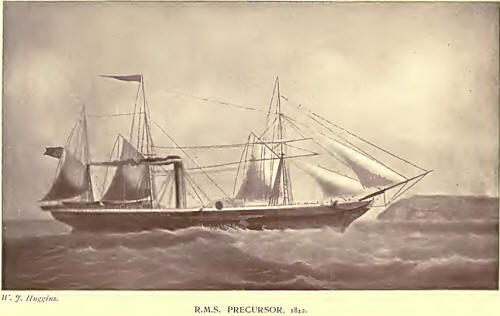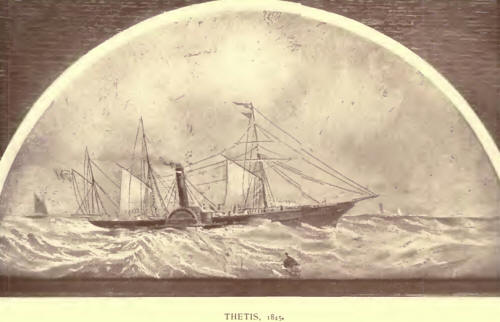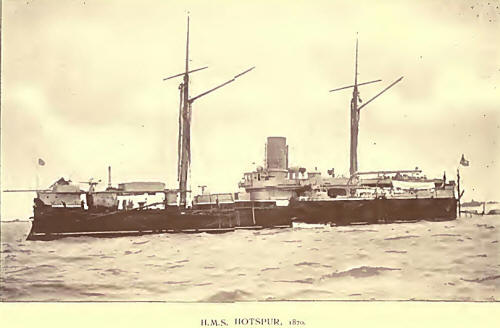|
Regular ocean navigation was now becoming universal
over the world, and companies such as the Royal Mail Company, the
Pacific Company, the P. & 0. Company, and others, rapidly came into
existence to exploit the several routes.
Following on the Cunard boats Napier constructed a
very fine steamer for the Eastern trade called the Precursor, which
was acquired by the P. & 0. Company. She cost over £65,000 sterling,
which was the largest sum lie had as yet received for a steam-ship.

Hitherto he had given out the hulls of his steamers,
placing most of them with his friend Mr John Wood. Troubles,
however, were experienced with sub-contractors, and it was also
found to be practically impossible to construct wooden vessels that
would keep their shape when driven by engines of large power.
To meet these difficulties, and keep abreast of the
time, he resolved to add iron shipbuilding to his business, and,
with this purpose in view, in 1841 he purchased some acres of ground
at Go van, which he fixed on as the most suitable site.
He had been very fortunate in his choice of Mr Elder
as manager of his Engine-Works, but as Elder knew little or nothing
of shipbuilding except from an engineering point of view, a suitable
naval architect had to be found. He was again happy in his selection
of his kinsman, Mr William Denny of Dumbarton, to fill this
position, as he had the reputation of being one of the best ship -
designers of his time. The terms of the agreement entered into are
set forth in Mr Denny’s letter of 1st November 1842, which is
countersigned by Mr Napier.
Glasgow, lsf November 1842.
Mr R. Napier,—
Sir,—I hereby offer to serve you as a draftsman,
modeller, and inspector of any steam-vessels, either of iron or
wood, that you may have at any time to build or repair, and to give
instruction to your sons regarding drafting and building of vessels.
In a word, I agree to give you the whole of my
personal services for three years on being paid by you for the first
year at the rate of £150 per annum and £10 of premium for every new
vessel that is built and completed under my direction and according
to your instructions. For the second year, I am to receive at the
rate of £175
per annum and £10 of premium on each vessel built
under my superintendence. In the third year, I am to receive at the
rate of £200 and £10 for each vessel built under my superintendence
for you. I am to be at liberty to complete my present engagement to
Messrs Coats & Young, and visit Belfast once each six weeks till the
vessel is built, &c. This agreement to be extended by Mr Moncrieff.
William Denny.
R. Napier.
It is specially to be noted that one of Mr Denny’s
duties was to instruct Mr Napier’s sons in the art of shipbuilding,
and when a few years later he left to found the firm of Messrs
William Denny & Brothers, his pupil, Mr James R. Napier, took charge
of the yard.
Thus equipped, Napier started to build his first iron
vessel, the Vanguard. She was a paddle-steamer of about 700 tons
register. In her construction Elder considered that it was
impossible to make substantial work with ordinary riveting, so he
bored the keel-plates and put in charcoal iron bolts, carefully
turned and fitted to the holes and riveted cold. With workmanship of
such a high order, and with a graceful form such as Mr Denny always
imparted to his models, success was certain, and the vessel was
universally admired.
She was launched on 29th June 1843, and at once
orders followed in quick succession for similar vessels, the various
companies engaged in the Channel trades abandoning wood and going in
for iron steamers. As evidencing the satisfaction which his iron
vessels gave, we quote a letter received from the Chairman of the
Dundalk Steam-Packet Company, whose steamer Dundalk closely followed
the Vanguard.
February 22, 1844.
Dear Sir,—As Chairman of the Meeting held on 20th
inst., it affords me much pleasure communicating the Resolution
enclosed passed on that day. I have to add that but one feeling
prevailed on the occasion,—That neither expense nor pains were
spared in the building and outfit of the Dundalk, alike gratifying
to the Company and creditable to the establishment where so fine a
vessel (admitted to be a first-class one) was constructed. Her form
is much admired for its symmetry, and her engines, in the opinion of
competent judges who have examined them, have been pronounced to be
models of skill.

Napier had been endeavouring to induce the Admiralty
to adopt iron instead of wood for steamers, and in the end of 1843
he received the following letter from his friend Sir Edward Parry :—
Admiralty, 23rd December 1843.
Dear Sir,—I am directed by the Lord Commissioners of
the Admiralty to request that you will come to London to communicate
with me yourself on the subject of the Tender you have lately sent
in for one or more iron vessels with engines.
If you can conveniently be at my office on Wednesday
next at 2| o’clock it will answer the intended purpose.—I remain,
dear Sir, yours very faithfully, E. W. Parry.
P.S.—I have appointed Mr Lloyd or Mr Murray to be
here to meet you at £-past 2 o’clock on Wednesday.
R Napier, Esq.
The result of the visit he paid was that he was
commissioned to build and engine three iron steamers for the Navy.
They were called the Jackal, Lizard, and Bloodhound, and these were
the first iron vessels in the service.
The prejudice of the officials was strong against
iron, as they feared it sounded the knell of the dockyards, and
efforts were put forth to make the boats unsuccessful. By increasing
the scantlings about 40 per cent above those customary in steamers
of a similar type, and by insisting on the frames being spaced only
nine inches apart, the vessels were made to draw much more water
than originally intended, and they were slow, consequent on the deep
immersion of their paddles.
Though the boats were comparative failures in respect
of speed, no blame was attached to Napier; and as the workmanship
was most satisfactory, about a year later he was entrusted with an
order for an iron screw frigate for the Navy. This vessel was called
the Simoom, and she was much larger than any steamer he had hitherto
undertaken. She was laid down on 20th December 1845, and remained on
the stocks for over three years, as the Admiralty had even then
acquired the habit of making alterations during construction, which
they were unwilling to pay for. At last, on 24th May 1849, she was
launched, not without mishap, in the presence of a large concourse
of people, and in about two years afterwards she was finished.
The delay in connection with this warship was a
serious matter to Napier, as she occupied so much space in his yard;
and the inconvenience caused may be the more readily appreciated,
when mention is made of the fact that during her construction he
entered into thirty new contracts. He made representations to the
Admiralty on the subject, and after delay received some recompense,
though not of an amount which he considered adequate.
The Simoom was a very efficiently constructed vessel,
and she was actively employed in the service as a troopship for
nearly forty years.
Mr Napier was characterised by liberality in his
views, and he made a point of opening his works to all, more
especially to naval officers who were desirous of acquiring a
knowledge of marine engines. He had many letters, such as the
following one from Admiral Sir Thomas Cochrane :—
Yester House, Haddington, October 7, 1851.
My dear Sir,—The Marquis of Tweeddale is very anxious
that his son Lord John Hay, a Commander in the Navy, should profit
by your splendid Establishment in Glasgow, and should receive your
permission to attend and take advantage of the scientific
instruction he can receive there; and you will confer a favour upon
me by permitting him to do so, and I can safely hold out as an
inducement that he will do ample justice to the opportunity that
will thus be offered to him, as he is a remarkably fine young man,
and was promoted by me when Commander-in-Chief in China entirely
from his merits as a promising officer.—I am, my dear Sir, very
faithfully yours,
Thos. Cochrane.
Robert Napier, Esq.
This enlightened policy had the effect of
establishing close and intimate relations with the Admiralty, and in
after years, when these apprentices (or rather we should call them
students) came to have power, they had strong leanings to Mr
Napier’s firm. Thus Admiral Lord John Hay, writing him in 1871 when
lie was in command of H.M.S. Hotspur, concludes his letter with a
postscript: “I feel still all the respect that is due to you from
myself as one of the old apprentices in your works so many years
ago.”
His relations with the naval men with whom he came in
contact were of the most harmonious character, and his kindness to
them was so much appreciated that a number of them presented him
with a valuable piece of plate.
Napier’s reply was in his happiest style:—

“Glasgow, 7th December 1844.
“My dear Sirs,—I am so taken e aback9 (to use a naval
word), that I feel at the greatest loss to offer you and your
brother officers my grateful acknowledgments for the very kind and
delicate manner in which I have been presented with a most elegant
and splendid testimonial, intrinsically valuable as a piece of
silver plate and as a work of art, but infinitely more so on account
of its generous donors, and as expressing by them the most
honourable, and to me by far the most gratifying, gift which I have
ever received, or am likely to receive, and which I trust will
remain as an heirloom in my family while it exists, and act as a
landmark to them to be kind and hospitable to all officers of the
Royal Navy.
“I feel deeply indebted to you and all whose names
have been sent to me along with the valuable silver Candelabrum and
Plateau, and beg to assure you all that, when I admitted naval
officers to my Works, I felt the greatest pleasure in having it in
my power to promote in the smallest degree the advancement of the
knowledge of steam machinery amongst the officers of the Royal Navy.
“I have always been highly pleased and delighted at
meeting with naval officers, and have often regretted that my
engagements otherwise prevented me from paying that attention that I
wished to pay. Nothing, I can assure you, would give me greater
pride and satisfaction than to have it in my power to have you all
seated at my table around this splendid testimonial of your
kindness, and have the pleasure of drinking a bumper to the success
of one and all of my naval friends; but as there is some doubt of my
meeting you all together, I can only say that so long as I have a
“roof-tree” above my head, one and all of you shall always have a
hearty welcome. Praying that God may bless you all, I am, my dear
Sirs, with kindest regards, yours most sincerely,
“R. Napier.
“To Captains Newell and Robb, E.N.,
London.”
As years went 011 this cordiality with his naval
friends increased, and whenever the Channel Fleet visited the Clyde
the invitation to West Shandon was accepted with alacrity, and a
most hearty welcome was always extended.
The last of these visits was in 1872, when Mr Napier
was over eighty years of age. In accepting the invitation Admiral
Hornby wrote him :—
H.M.S. Minotaur, Greenock, July 3, 1872.
Dear Mr Napier,—Pray accept my best thanks for your
kind note of yesterday just received, and the hearty welcome to the
Clyde which it conveys.
I am very sorry I cannot speak more positively to the
time at which I may be able to have the pleasure of calling on you.
I hope it will be on Friday afternooD, but I have to receive the
Provost of Dumbarton in the forenoon, as he wishes to see the ship,
and I am in hopes that my wife may join me here, probably on Friday
morning, and if so, arrangements I have made may have to be
deferred.
But if you will allow me to take my chance of finding
you at home on that day, I hope to be able to reach you between 2
and 4 p.m. and to bring a few officers in our steam-launch to see
the beauties of West Shandon, and to make the acquaintance of its
illustrious owner.—Believe me, yours very truly, Geoffrey Hornby.
Robert Napier, Esq.
He was on equally good terms with the powers that be
at Whitehall. In concluding a letter in 1868, Sir Spencer Robinson,
who was then Controller of the Navy, expressed himself in these
gratifying terms :—
May God bless you, my dear old friend. One of the few
bright spots in my official career is that it has again brought me
into relations with you, and made me know still better than of old
all that was valuable, excellent, and sterling in your honoured
self.
Few contractors have ever been favoured with such
expressions of esteem from the Controller of the Navy, but this
extract shows the very intimate relationship that existed between
the British Admiralty and Mr Napier.
These busy years did not pass without changes in his
immediate family circle. His brother, the Rev. Dr Peter Napier, was
in 18M presented to the College Church in Glasgow, but, as was not
unusual in those Disruption days, there was a dispute about his
settlement.
Canon Melvill of St Paul’s, brother of the Secretary
of the East India Company, was an intimate friend of Robert Napier,
and as he was one of the most celebrated preachers of the time he
sent him a copy of Dr Peter’s sermons. In acknowledging them the
Canon wrote as follows :—
East India Company, February 5, 1845.
My dear Napier, — Many thanks for your brother’s
sermons. They are excellent both in matter and style, quite good
enough for Episcopalians; I had almost said too good for
Presbyterians. Certainly if the hearers of such sermons object to
the preacher they ought to be doomed to some ranting raving fellow
who will wear out a red cushion in twenty-four hours. . . .
Many thanks for your kind invitation to Shan don. You
are as good a fellow-as ever lived, and I owe you more than I can
pay for all sorts of kindness. . . .—Most truly yours,
Henry Melvill.
Mr Napier, in the midst of his prosperity, was always
most attentive to his old parents, and there was an annual gathering
at Dumbarton. His cousin, the Rev. Dr Mathieson of Montreal, writing
him in the end of 1843, concludes his letter saying—
We can only expect the old folks now should feel the
burden of years. Few have attained their days amidst so much peace
and comfort. The united ages of the first generation—viz., your
father and mother, my own, and Aunt. Nancy,
would amount to a considerable sum. May they all be
preserved for many years to come. I hope it will be long before the
General Assembly at Dumbarton, on Hogmanay, will be dissolved.
My kindest regards to Mrs Napier and all around your
fireside, not forgetting Uncle and Aunt.
Uncle, I daresay, now and then wafts an “ Och, och,
poor man,” across the Atlantic.
In 1846 his mother died at the age of eighty-four
years, and two years later his father passed away at the same
advanced age. A few months later he lost his youngest son Robert,
and he was buried beside his grandparents in Dumbarton.
In the immediately ensuing years all his sons and
daughters married and set up establishments of their own.
Mr Napier ceased to live in Glasgow, and henceforward
resided permanently at his house on the shores of the Gareloch. |

